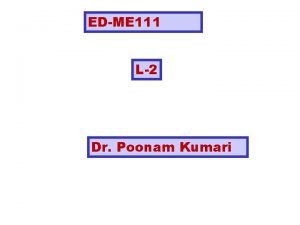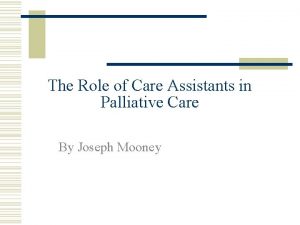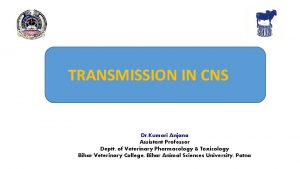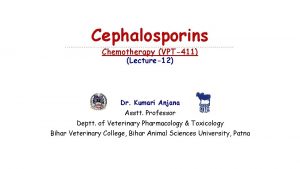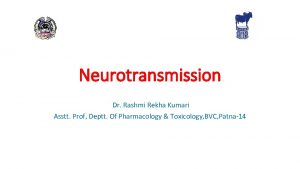ANTICONVULSANT S Dr Kumari Anjana Assistant Professor Deptt



















- Slides: 19

ANTICONVULSANT S Dr. Kumari Anjana Assistant Professor Deptt. of Veterinary Pharmacology & Toxicology Bihar Veterinary College, Bihar Animal Sciences University, Patna

ANTICONVULSANTS Anticonvulsants are drugs that depress the CNS and control convulsions. These drugs are intended for the treatment of various convulsive/ seizure disorders in man and animals. The primary use of anticonvulsants is in epilepsy hence they are also called antiepileptics.

Epilepsy The term epilepsy refers to a disorder of brain function characterized by the periodic and unpredictable occurrence of seizures. Epilepsy is a collective name given to a group of chronic CNS disorders (syndrome) manifesting --spontaneous occurrence of seizures of brief duration, loss or disturbance of consciousness, abnormal body movements, abnormal and excessive electroencephalographic (EEG) discharges, and sensory, autonomic and/or behavior phenomenon. Seizures are thought to arise from the cerebral cortex in brain and their manifestations depend on site of the focus or region into which the discharges spread. In veterinary medicine, epilepsy is most common in dogs (1% of all canine diseases), although cases also occur in cats, horses and cattle.

Classification The epilepsy is classified mainly on the basis of occurrence of seizures in humans but may also include animals. Epileptic seizures have been classified into 1. Generalized Seizures i) Tonic-clonic seizure/Grand mal epilepsy ii) Absence seizure/Petit mal epilepsy iii) Myoclonic seizure 2. Partial (localised or focal) Seizures i) Simple partial seizure/Cortical focal epilepsy ii) Complex partial seizure/Psychomotor epilepsy iii) Partial with secondarily generalized tonic-clonic seizures

1. Generalized seizures: Generalised seizures are bilateral (involve both hemispheres) and symmetric, and do not have a specific locus of onset in the brain. The most common generalized seizures include: i) Tonic-clonic seizure/Grand mal epilepsy: It is characterized by tonic rigidity of extremities followed by massive clonic jerking for several minutes. It is the most common form of epilepsy in dogs.

ii) Absence seizure/Petit mal epilepsy: It is characterized by momentary loss of consciousness associated with staring and cessation of activities. There is clonic jerking of eyelids but no motor activity. In human beings, absence seizures mainly occur in children; whether it occurs in dogs is unclear. iii) Myoclonic seizure: It is characterised by a brief (perhaps a second) shock like condition of muscles of a limb/extremity or the whole body. The myoclonic epilepsies occur in dogs but treatment is usually not undertaken.

2. Partial/Localised seizures: Partial seizures originate in a specific part of brain and are often associated with the structural disease of brain. Partial seizures are less commonly seen in canines than the generalized seizures. In animals, partial seizures are more difficult to diagnose and treat than generalised seizures and, therefore, carry a poorer prognosis. Partial seizures may be subdivided according to the degree of body movements.

i) Simple partial seizure/Cortical focal epilepsy: It is associated with preservation of consciousness. Seizures are confined to a group of muscles or localised sensory disturbance depending on the area of cortex involved in the seizure.

ii) Complex partial seizure/Psychomotor epilepsy: It is characterized by impaired consciousness with bizarre and confused behaviour, and purposeless movements. In this epilepsy, the discharges become more widespread and complex motor or behavioral aberrations are seen. The seizure focus is located in the temporal lobe of the cerebrum, so it is also called temporal lobe epilepsy.

iii) Partial with secondarily generalized tonicclonic seizures: In this type, the partial seizure (simple or complex) occurs first and evolves into generalised tonic-clonic seizure with loss of consciousness.

3. Other terms: Apart from epileptic seizures classification given above, some additional terms are used to specify type or condition of epilepsy. These include Idiopathic/Primary epilepsy: The term idiopathic or primary epilepsy is used for recurrent seizures resulting from a functional disorder of the brain. This includes those cases where no cause for the seizure can be identified hence no histopathological lesions can be demonstrated in it.

ii)Secondary/Symptomatic epilepsy: This type of epilepsy designates the disorder when factors like neoplasm, infection, poisoning, fever, developmental abnormality, cerebrovascular disease, withdrawal of certain drugs, or various metabolic disorders contribute to the cause of the disease.

iii) Cluster epilepsy: The term 'cluster epilepsy' is used when there are multiple isolated seizures in a short period of time. Some dogs usually of the large breeds like German Shepherds or Golden Retrievers suffer from cluster epilepsy that is 3 to 15 seizures in close succession over 24 to 48 hours followed by an interval of 1 to 3 weeks.

iv) Status epilepticus: The term 'status epilepticus' is used to describe epileptic seizures that are so frequently repeated or so prolonged as to create a fixed and lasting epileptic condition. In this type, patient has a subsequent generalized seizure before recovering from the initial seizure. In status epilepticus, there may be extreme exhaustion, hyperpyrexia or even death.

Pathophysiology of Seizures are clinical result of rapid and excessive neuronal discharge in the brain. These usually result from an alteration in normal neuronal excitability. Normally, a balance of neuronal excitation and inhibition exists such that electrical activity is not propagated unrestrained. If the balance is altered in favour of inhibition, sedation and anesthesia occurs and if neuronal excitation predominates over inhibition, the potential for a seizure increases.

For excitation to abnormally predominate over inhibition, one of at least 4 possible events are likely to occur. a) There may be increased availability of excitatory neurotransmitter such as glutamate and acetylcholine due either to increased production and release or to impaired metabolism or re-uptake. These neurotransmitters bind to their respective receptors and open cationic channels for Na+, Ca++, and perhaps K+. This causes the resting membrane potential to depolarize, producing an action potential and excitatory response.

b) There may be decreased availability of inhibitory neurotransmitter such as GABA, the most potent inhibitory neurotransmitter in the CNS. The decreased activity of inhibitory transmitters allows excitatory neurotransmitters to predominate and produce excitation. c)There may be altered neuronal membrane function that can lead to excessive depolarisation (e. g. , alteration of the Na+ pump) or permeability changes in the cell membranes (induced, for example, by hypoxia, inflammation or trauma). A derangement of cellular metabolism alters also resting membrane potential or ability of the cell to return to resting membrane potential.

d)There may be altered extracellular potassium and calcium concentrations. During a seizure, extracellular potassium increases and calcium decreases. This results in increased neuronal excitability which facilitates the initiation and spread of seizure.

Thank You
 Seizures and tremors
Seizures and tremors Anjana kundu
Anjana kundu Anjana appachana
Anjana appachana Promotion from associate professor to professor
Promotion from associate professor to professor Fok ping kwan
Fok ping kwan Sonia kumari with dog
Sonia kumari with dog Reema kumari
Reema kumari Lemuria
Lemuria Sonia kumari
Sonia kumari Zilla parishad
Zilla parishad Chaplair v kumari
Chaplair v kumari Raj kumari amrit kaur coaching scheme
Raj kumari amrit kaur coaching scheme Dr poonam kumari
Dr poonam kumari Puja kumari xxx
Puja kumari xxx Adminastrative assistant day
Adminastrative assistant day Palliative care assistant
Palliative care assistant Assistant teacher of gps
Assistant teacher of gps Ucl library assistant
Ucl library assistant What is a district commissioner
What is a district commissioner Junior assistant scoutmaster
Junior assistant scoutmaster












